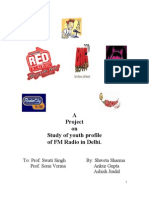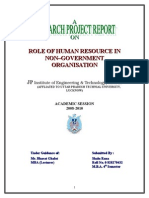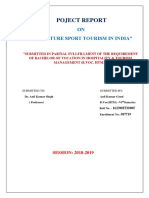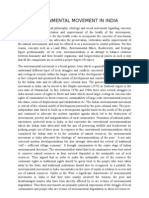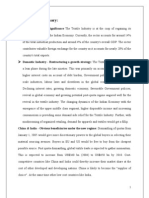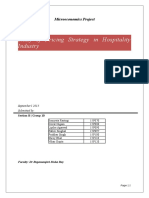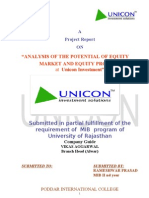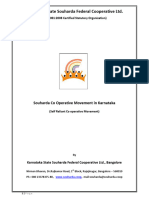Environmental Movements in India: Some Reflections
Environmental Movements in India: Some Reflections
Uploaded by
DrVarghese Plavila JohnCopyright:
Available Formats
Environmental Movements in India: Some Reflections
Environmental Movements in India: Some Reflections
Uploaded by
DrVarghese Plavila JohnCopyright
Available Formats
Share this document
Did you find this document useful?
Is this content inappropriate?
Copyright:
Available Formats
Environmental Movements in India: Some Reflections
Environmental Movements in India: Some Reflections
Uploaded by
DrVarghese Plavila JohnCopyright:
Available Formats
1/17/2015
DiscussionPaper64
DiscussionPaper64:Reddy,RatnaV.:EnvironmentalMovementsinIndia:SomeReflections
DiskussionsschriftenderForschungsstellefrInternationaleWirtschaftsundAgrarentwicklungeV
(FIA),Nr.64,Heidelberg1997
____________________________________________________________________
IIntroduction
TheconcernforthepresentdayenvironmentalproblemsinmostofthedevelopingcountrieslikeIndiais
of relatively recent origin. Even the recent awareness and concern for environmental protection at the
policylevelisadonorinducedandatthegrassrootslevelitisduetoeffortsbyindividualsandNGOs.In
theabsenceofgroundlevelawarenessandconcern,environmentalaspectshaveremainedmoreorless
peripheral to the contemporary social movements in India. Some of the contemporary movements,
however,acquiredthestatusofecologicalorenvironmentalmovementsinretrospectasthesemovements
havewidenedtheirfocusfrombasicsurvivalneedstoecologicalconcerns(seeSethi,1993andGadgil
and Guha, 1994). In genera l these movements are often grouped under tribal or peasant movements
(Shah, 1990) and also under new social movements (Omvedt, 1993 and Wignaraja, 1993).Someeven
title them as middle class or elitist movements (Shah, 1990 Sethi, 1993). The reason bein g that
ecological aspects are linked with the problems associated with peasants and tribals whose survival is
attachedtothestatusofnaturalresources.Theproblemsordemandsoftribalaswellasnontribalpoor
are often articulated by urban middle c lass and elite. In the context of a coalition between affected
peopleandthemiddleclassspokespersonstherealissuestendtogetcloudedasthedebateisdrawninto
differentforumsinordertoattractnationalandinternationalattention(Sethi,1993).
Environmental movements in India, therefore, are not necessarily for the 'green' or 'clean' earth or for
savingmankinds'heritageandendangeredspeciesasinthewest,butfortheverysurvivalofthelocal
poor(Rao,1994).Evenamongtheseecologicalmovements,onlyafewcanclaimsuccessinachieving
someoftheirobjectives.Ontheotherhand,theoverwhelmingpopularityorcoveragereceivedbysome
of these movements overshadows the importance of other environmental problems whi ch may be
equally,ifnotmorestrident.Andthesuccessofthemovementisoftenlinkedwithits'popularityrather
thantheimportanceoftheissue.
Thispaperisanattempttounderstandthereasonsbehindthepopularity/successorfailureofmovements
incontemporaryIndia,whichhaveenvironmentalconcernsastheirobjectiveatonestageorother.Some
of the relevant questions i n this regard are: (i) what are the characteristics of and conditions for
successful movements in contemporary India (ii) to what extent these movements address the
environmentalconcernsindifferentcircumstancesandiii)whatarethefactorsotherthanenvironmental
concernsthatledtothesuccessorfailureofthesemovements.
Thoughtheextentoflocalsupportisvitalforthesuccessofanygrassrootslevelmovement,onehardly
finds that the initiative for environmental protection in India comes from the people concerned. These
concerns are articulated by the spokes persons to attract wider support, internal as well as external
supportlikeNGOs,donoragencies,etc.Sofar,theexperienceisthatenvironmentalgroupsareoftenat
logger heads with the State whose actions in a democratic set up are suppose d to reflect peoples
demands and aspirations. Unless the thrust for environmental movements come from the people
concerned, it is unlikely that these movements would address the broader ecological dimensions of
development which remained peripheral to the se movements. This aspect, however, is given due
http://www.sai.uniheidelberg.de/intwep/fia/DISKUS64.htm
1/11
1/17/2015
DiscussionPaper64
importance in the case of a few micro level movements where sustainable development is the main
objective.Andtheresultsorachievementsofthesemovementsareexemplary.Itislikelythatthetypeof
environmentalissuesaddressedbycontemporarymovementswouldbedifferentiftheinitiativecomes
entirely from the people concerned. Besides, the sustenance of the movements depends on peoples'
supportalthoughtheirpopularitymaycomefromleadershipandexternalsupport.
With a view to understand the nature and direction of modern environmental movements in India, an
attempt is made in this paper to reflect on the experience of some of the important and popular
movements.Thediscussioniscarriedoutseparatelyforpopularmovementsandmicrolevelmovements.
It may be noted that popular movements are not necessarily synonymous with macro or country wide
movements.Thesemovementscanbetermedasmacroonlyintermsoftheirpopularityratherthantheir
supportbase(oraffectedregions).Whilethemainobjectiveofthemacromovementsistoinfluencethe
policy,themicrolevelmovementsaimataresultorientedsustainabledevelopmentpractices.Ourmain
focushereisonthereasonsfortheirsuccessorpopularityratherthanontheirachievements.Thispaper
isdividedintofivesections.Thefollowingsectiondealswiththecharacteristicsandconcernsofsome
importantpopularmovementswhilesectionthreeexamineswhysomemovementsarepopular.Section
four presents the approach and concerns of micro level movements and the last section reflects on
experience of these movements in addressing the basic social objectives visavis environmental
concerns.
IIThePopularMovements
TheoriginofmodernenvironmentalismandenvironmentalmovementsinIndiacanbeascribedtothe
Chipko movement in the central Himalayan region in the early 1970s. Chipko movement, launched to
protect the Himalayan forests from de struction, has its' roots in the preindependence days. Many
struggles were organized to protest against the colonial forest policy during the early decades of 20th
century.Peoples'maindemandintheseprotestswasthatthebenefitsoftheforest,especiallytherightto
fodder, should go to local people (Bahuguna, 1990). These struggles have continued in the post
independent era as the forest policies of independent India are no different from that of colonial ones.
However,theoriginof'Chipko'[chipakjayengetohug]hastakenplaceduringtheyear1973.Inearly
1973theforestdepartmentrefusedtoallotashtreestotheDashauliGramSwarajyaSangha(DGSS),a
local cooperative organization based in Chamoli districts, for making agricultu ral implements. On the
otherhand,theforestdepartmentallottedashtreestoaprivatecompany,i.e.,SymondsCo.Thisincident
provoked the DGSS to fight against this injustice through lying down in front of timber trucks and
burningresinandtimberdepotsaswasdoneinQuitIndiamovement.Whenthesemethodswerefound
unsatisfactory, Chandi Prasad Bhat one of the leaders, suggested of embracing the trees and thus
'Chipko' was born (for details see Bahuguna, 1990 and Guha, 1989). This form of prot est was
instrumental in driving away the private company from felling the ash trees. With its' success the
movement has spread to other neighboring areas and then on the movement is popularly known as
Chipko movement internationally. Only during 1970s thi s [now Chipko] movement started tending
towardconcentratingonecologicalissuessuchasdepletionofforestcoverandsoilerosion.
Chipko movement with its wide following and success, though modest in achieving some of its
objectives,canbetermedasawatershedinenvironmentalmovementsinIndia.This,infact,kindledthe
environmental aspects of development an d gave rise to numerous conflicts and protests over natural
resourcesandecologicalissues.However,despitenumerousforestbasedmovementsduringthelasttwo
decadesinIndia,noneofthemhadattracted(asmuchasChipkodid)publicsupportorinfluencedthe
Statepolicies.ThismaybeattributedtothreeimportantaspectsofChipkomovement.Firstly,theclose
links between the livelihoods of the local people and the nature of the movement. The local people
http://www.sai.uniheidelberg.de/intwep/fia/DISKUS64.htm
2/11
1/17/2015
DiscussionPaper64
considerChipkoasafightforbasicsubsistence denied to them by the institutions and policies of the
State (Guha, 1989). In addition, the specificity of the region where involvement of women in the
contribution to households subsistence and the antialcohol campaign has led to the overwhelmin g
support of women which is unique to the Chipko movement. Moreover, as aptly described by Guha
(1989,p.178)the'private'faceofChipkoismoreapeasantmovement,whileitspublicprofileisseenas
anenvironmentalmovement.Further,ithasafaceofwomens'movementaswell(Omvedt,1993).Itis
interestingtonotethatinthelaterstageswhenChipkoceasedtogobeyondenvironmentalconcerns,i.e.,
limitingitselftoprotectingandconservationoftrees,theproblemsstartedsurfacing.
The second aspect is with regard to the nature of agitation. Unlike other environmental movements
Chipko has strictly adhered to the Gandhian tradition of freedom struggle, i.e., nonviolence. To quote
Guha 'there is the veneer of Gandhi anism with which Chipko is cloaked, a matter of some
embarrassment for a state claiming to be the rightful successor of the freedom struggleandupholding
GandhiastheFatherofNation.InthismannerChipkohad,knowinglyorunknowingly,successfullyex
ploited the ambiguities in the dominant ideology of the Indian state' (Guha 1989, p 177). Thirdly, the
simplicityandsincerityoftheleaderslikeShriSunderlalBahugunaandtheiraccesstonationalleaders
likeMrs.IndiraGandhiandotherpoliticiansandofficialsalsohelpedtothesuccessofthemovementto
alargeextent.
DespiteitspopularityandsuccessChipkomovementisstillconsideredtobeincompleteandmodestasit
limiteditselftoecologicalaspects[inthelaterstages]ofprotectingtreestotheneglectoflocalpeoples
requirements. In fa ct, to start with, Chipko movement has had six demands only one of which is
complete stoppage of commercial cutting of trees. The other demands include: (i) on the basis of
minimum needs of the people, a reorganization of traditional rights should take place (ii) arid forest
shouldbemadegreenwithpeoplesparticipationandincreasedtreecultivation(iii)villagecommittees
shouldbeformedtomanageforests(iv)forestrelatedhomebasedindustriesshouldbedevelopedand
the raw materials, money and technique for it should be made available and (v) based on local
conditionsandrequirements,localvarietiesshouldbegivenpriorityinafforestation(Mukul,1993).The
recentevidenceshowsthatduetotheneglectofecodevelopmentlinkages(markets,techniques,forest
basedindustries),theobjectiveofamelioratingtheconditionsoflocalpeopleintheseregionsremainsa
distinctdream.Ifthesituationcontinues,i.e.,increasingthreatstothelivelihoodsoflocalpeople,itmay
jeopardize the achievements of the Chipko movement and lose the peoples support. In fact, the close
downoflocalindustrieshasresultedinmostentrepreneurs,whoareattachedtothemovement,feeling
alienatedfromit(Mukul,1993,p.621).
The other popular movements of importance in India, which have environmental protection as one of
their objectives, relate to major dams. Notable among them are Tehri Dam, Silent Valley Project and
NarmadaValleyProjects.Thelongeststruggleamongtheantibigdamprotestswastheoppositionto
TehriDam,beingconstructedontheriverBhageerathiintheGarhwalregion.TheTehriBaandhVirodhi
Sangarshan Samithi, committee for the struggle against the Tehri Dam founded by veteran fre edom
fighterVeerendraDattaSaklani,hasbeenopposingtheconstructionformorethanadecade.Themajor
objectionsinclude,seismicsensitivityoftheregion,submergenceofforestareasalongwithTehritown,
etc. ( for details see D' Monte, 1985 as quoted in Gadgil and Guha, 1994). Despite the support from
other prominent leaders like Sunderlal Bahuguna the movement has failed to gather enough popular
support at national as well as international levels and the government is determined to complete th e
project. For, according to the latest reports (various daily news papers during MayJune, 1995), the
constructionofthedamisbeingcarriedoutwithpoliceprotectionasShriSunderlalBahugunaissitting
on fast unto death. After Priministers' assura nce to review the project again Shri Bahuguna ended his
fast.
OneoftheearlyandcompletesuccessesofenvironmentalmovementswastheabandonmentoftheSilent
http://www.sai.uniheidelberg.de/intwep/fia/DISKUS64.htm
3/11
1/17/2015
DiscussionPaper64
Valley hydro electric project in Kerala.1) This movement was organised by the Kerala Sastra Sahitya
Parishat(KSSP)incollaborationwithwildlifeconservationists.Inthisproject,however,therewasno
localpeople'sinvolvementastherewasnodisplacementofpeople.Themovementwasfoughtprimarily
on environmental grounds and mostly at the intellectual level. The major concerns of this movement
weretheadverseenvironmentalimpactonSilentValley,oneofthelastsurvivingnaturaltropicalforests
in India and protecting a rare breed of monkey, liontailed macaque. With the active support from the
InternationalorganizationslikeWorldWildlifeFundandtheInternationalUnionfortheConservationof
NatureandNaturalResourcesthemovementassumedInternationalimportance(Sethi,1993).Thoughit
gainedpopularityandcoverage,theultimatesuccessofthemovementwasattributedtothethenPrime
Minister Mrs. Indira Gandhi's desire to enhance her image among the International Conservation
Community(D'Monte1985asquotedinGadgilandGuha1994).
ThemostpopularmovementintheenvironmentalhistoryofIndiaisthemovementagainsttheNarmada
RiverValleyProject.Thoughthemovementstartedasearlyaslate1970s,alongwiththeclearanceofthe
project,itreceivedmomentumonlyduringlate1980s.Tostartwith,thismovementwascenteredaround
the issue of human rights. In fact, some of the main leaders of the movement at present like Medha
Patkarwereworkingtoward proper rehabilitation programmes for the dam displaced. Duetoimproper
implementationoftherehabilitationprogrammesbytheStatethehumanrightsactivistshavebecomethe
articulatorsofantidamprotests.Theirdemandsincludedcompletestoppingofthedam,resettlementand
rehabilitation benefits to the oustees (Wood, 1993). These demands were aptly supported by
environmentalists who oppose construction of large dams for ecological reasons. The movement,
however, gained wider public attention with mobilization and organization of oustees (mostly tribals )
andthejoiningoftheeminentsocialworkerslikeBabaAmte,SunderlalBahugunaandMedhaPatkar.
Thoughitswiderpublicattentionisduetoitscoverage(impact)inthreestates,themostnotablefeature
ofthismovementistheinternationalsupportithasreceived.Infact,themainreasonbehindtheWorld
Bank'swithdrawaloffundingtotheprojectwasduetointernationalpressures.Tolistafewinstances:
Japaneseenvironmentalistspersuadedtheirgovernmentinblockingthemoneyadvancefortheproject.
Similarly, the US environmental groups have worked hard to stop World Bank funding (Gadgil and
Guha,1994,p173).Withthisinternationalsupport,theleadersofthemovementreceivedasympathetic
hearingfromanUSCongressionalSubCommittee.InthewakeoftheWorldBank'sindependentreview
committee report, the European Parliament urged its member countries to instruct their World Bank
directorstosuspendallfurtheraidtoSardarSarovarandinthefinalvotingallthedonorcountriesvoted
against funding while poor recipient countries voted for continuation (Wood, 1993). This kind of
international support is something unprecedented in Indian environmental history. The completion of
Narmada Valley Project is not directly linked with Wo rld Bank funding and hence the success of the
movement. It is also unlikely that the project would remain half finished forever. On the other hand,
without international pressures it would have been very difficult for the leaders of Narmada Bacho
Andolan(SaveNarmadaAgitation)tostopWorldBankfundingontheirown.Eventhismaybetermed
asonlyapartialsuccessofthemovementastheultimatesuccessliesinconvincingorpressurizingthe
governmenttostoptheprojectwithpeoplessupportwhichismostunlikelyinthepresentsocioeconomic
conditionsinIndia.
Itisonlyintriguingwhy'Narmada'ValleyProjectbecamesuchapopularmovementandreceivedsucha
support from international environmental organizations. Whereas, environmental disasters like Union
CarbideGastragedyatBhopal2)(whichisalsolocatedinoneofNarmadaStates,i.e.,MadhyaPradesh),
where about 2500 people have lost their lives while thousands become permanently disabled, failed to
receivedueattentiondespiteits'potentialforamassmovement.Thoughthe caseis beingdraggedfor
yearsinIndianCourtsatthecostofvictimssuffering,theincidentsomehowfailedtocapturethefancy
ofenvironmentalgroups.NopoliticalpressureswhatsoeverwerebroughtontheUSGovernmentorfor
thatmatterontheIndianGovernmenttomaketheUnionCarbidepaythefullcompensation.Infact,US
http://www.sai.uniheidelberg.de/intwep/fia/DISKUS64.htm
4/11
1/17/2015
DiscussionPaper64
andIndianGovernmentsweretryingtopushthecasetotheothercountry'scourts.WhiletheUSlobbied
forthecasetobesettledinIndianCourtsasitamountstolowercompensationandlessdamagetoUnion
Carbide,theIndianGovernmentwasdoingthereverseinordertogetthemaximumcompensation.For,
in the context of the case being settled in the US Union Carbide's entire assets will be valued for
compensationbecausethemultinationalcorporation'sheadquartersarelocatedthereandhencetheentire
UnionCarbideCorporationwillbeheldresponsible.Whereas,inthecaseofIndianCourtsonlyUnion
Carbide of India will be held responsible rather than the corpora tion in its entirety. Finally, in the
absenceofenoughexternalpressuresfromenvironmentalgroupscoupledwiththeIndianGovernment's
weakbargainingpowerthecasewaspushedtotheIndianCourts.
IIIWhySomeMovementsarePopular?
Atthisjunctureitisimportanttounderstandthecharacteristicsandqualitiesofthemovementsthatmade
themsopopularwhileothersarenot.Accordingtothestandarddefinitionofasocialmovementitisa
deliberatecollectiveendeavortobringchangeinanydirectionandbyanymeans,itshouldhavesome
degree of organization and normative commitment and active participation on the part of its' members
(Shah, 1990, pp.1617). Movements with multi stranded objectives and fas tchanging can sustain for
longerperiods.Thecohesivenessofthemovementinintegratingmultipleobjectiveswithoutlosingtrack
of the ground level [initial] protests are vital for its success. Let us now analyze the above discussed
movements in the l ight of these aspects. The above discussed movements have three distinct bases
ChipkowithforestbaseSilentValley,TehriandNarmadaarebigdamcontroversiesandBhopaltragedy
isurbanbased.Here,wefocusourdiscussiononthereasonsforpopularityofsomeofthesemovements.
ThesuccessorpopularityofChipkomovementcanbeattributedtoitslonghistory,multipleobjectives
which have changed over time, committed leaders and their stature at local and national level. As the
struggle against forest policy of the state had started during the preindependence time, it has
accumulated over the period a wider local support base and provided a strong ground for the Chipko
movement. Chipkos' strength lies in its' multiple objectives with a wide range such as, p rotecting the
livelihoods of peasants, antiliquor campaign, greening the hills in a sustainable fashion, etc. Over the
time,thearticulationoftheproblemshasalsochanged.DuetothisreasonChipkoisoftentitled/confused
as peasant/ womens'/ enviro nmental movement. However, of late chipko movement has tended to
concentrate on ecological issues alone and hence started losing its' popular base. Some of its' early
successcanbeattributedtothecommitmentoftheleadersandtheirinfluenceoncommonpeopleaswell
aspoliticalleaders.Butthesameleadership(ShriSunderlalBahuguna)couldnothavesimilarsuccessin
mobilizingthepeopleorconvincingthestateinthecaseTehridam.
The absence of popular support in the case Tehri Dam may be attributed to its' more or less single
objective which is rather ecological (seismic impact and submergence of forest lands). The people
involvedarenonhomogeneouscommunitywithmoderninfluences[peoplefromTehritown]andhence
difficult to mobilize. Similarly, in the case of Tehri the approach of following different strategies for
drawingthesupportofavariousnationalandinternationalforumismissing.Besides,TehriDamdoes
notdependsomuchonexternalfundingasisthecasewithNarmada.
While the success of the movement against Silent Valley Project, without any grassroots support, is
mainlyofintellectualnature,thepopularityofNarmadahasmanydimensions.Narmadamovement,like
Chipko,hasstartedwithaddressingtheproblemsoflivelihoodsoflocalpeople[tribals],traversedinto
humanrightsissuesandfocusedonenvironmentalconcernswhilesuggestinganalternativedevelopment
paradigm. Interestingly, the strategy of the leadership has been to address all th ese dimensions
simultaneouslyinaneffectivemanner.Tostartwithits'massbaseisthedamaffectedtribalcommunities
http://www.sai.uniheidelberg.de/intwep/fia/DISKUS64.htm
5/11
1/17/2015
DiscussionPaper64
which are homogeneous and removed from modern influence and hence easier to organize (Patkar,
1992). Narmada agitation, apart from ad dressing different objectives, has been following different
strategiestoinfluencenationalandinternationalforums,i.e.,explainingthingsfromonepointofviewto
thehumanrightsactivists,andfromanothertotheenvironmentalgroupswithoutlosingtouchwiththe
local tribals (Patkar, 1992). Moreover, the activists are very much involved in the socioeconomic
developmentofthetribalcommunities,i.e.,buildingschools,dispensaries,etc.Themainreasonforits
international recognition is the t ime point at which the movement has started. Narmada Andolan had
takenoff during late 1980s when the North South conflict regarding environmental issues had
sharpened. Protecting the environment in the South has become one of the main agenda of the int
ernationalpolicyoftheNorth.ThishasledtotherecognitionandactivesupporttoNarmadaagitation
fromgovernmentalandnongovernmentalorganizationsabroad.Thissupportinturnisinstrumentalin
bringingpressureonWorldBanktostopthefundingoftheprojectasitisantienvironment.
Ontheotherhand,theBhopaltragedydoesnotseemtohavethesequalitiesofamassmovement.Itwas
a sudden tragedy dawned upon a heterogenous urban community. Moreover, the Bhopal Act by the
GovernmentofIndiawaspassedinMarch1985consolidatingallclaimsarisingoutofBhopaldisaster
andmakingthegovernmenttheonlycompetentauthoritytorepresentthevictims.Thishasleftnospace
tomobilizepeoplearoundtheissueoflivelihoods.Intheabsenceofanydirectlinkbetweenlivelihoods
andenvironmentthelaterwasneithergivendueimportancenorarticulated.Theissuehasalwaysbeen
the compensation for the victims but never with regard to future policy on environmentally hazardous
industries.For, at that particular point in time any issue other than compensation would have drawn a
blank in terms of local support. Therefore, environmental issues per se may not have the potential to
drawmassresponse.
Similarly, examples are abound where important environmental problems are neither articulated nor
broughttotheforebyenvironmentalistsinIndiainordertobringanypolicychanges.Nomovementsare
organisedwithregardtourbanorindustrialpollutiondespitethefactthatquiteafewlivesarelostona
regular basis every year. There were no attempts to popularize some of the important region specific
environmentalproblemssuch as desertification, water logging or salinization in various regions which
are equally harmful as submergence of forest areas under Narmada Reservoir. Surprisingly, the day to
daystatepoliciesregardingenvironmentalprotectionarehardlycontestedbytheenvironmentalgroups
inthecountry.Forinstance,recentlyinordertoencouragesmallscaleindustryitwasexemptedfrom
the pollution control act. The decision of the environmental ministry to close down some of the sugar
factories (13) which are not adhering to the environmental regulations despi te several warnings was
ultimately waived by the Cabinet Committee which was headed by the Prime Minister himself.
Ironically, no environmental group has protested against these policy decisions, nor they received any
coverageinthepressexceptforstatingthefact.
Despite recommendations from various committees the state has failed to address the most pressing
demand of the Indian agricultural sector, i.e., proper irrigation management. The subsidized and
mismanaged irrigation distribution system s are resulting in numerous environmental problems. The
environmentalgroupsneithertrytoinfluencethepolicynormobilizeandconvincethefarmerswhichis
vitalinthisparticularissue.For,thismayresultinantagonizingthefarmlobbyasawhole.Theremay
notbeanypopular(grassrootslevel)supportforsuchamovement.For,theseproblemsareoflongrun
nature and do not affect the immediate survival of the local people. Moreover, the impact is realized
graduallyoveraperiodandhencemaynothavemassappeal.Therefore,thepresenttrendindicatesthat
environmentalmovementsarelinkedtoimmediatelivelihoodsandhumanrightsissueswhichcanarouse
popularsupportratherthanenvironmentalconcernsassuch.Thistrend,thoughreflectsthepresentday
prioritiesofthepeople,itshowslackofproperperspectiveonthepartofenvironmentalmovements.For,
environmentalprotectionanddevelopmentareexpectedtogohandinhandatleastinthelongrun.
http://www.sai.uniheidelberg.de/intwep/fia/DISKUS64.htm
6/11
1/17/2015
DiscussionPaper64
Perhaps this may be the reason why environmental concerns receive least priority even at the policy
level. For instance, in the case of Narmada while the activist groups try to influence the policy in the
nameofhumanrights(includinglivelihoods)andenvironmentalproblemsofthedam,theStatetriesto
counter this with the argument of ameliorating poverty in the down stream areas (beneficiaries of
irrigation). In this context, what is missing in the approach is sorting out of the p roblems at the pre
execution level which is the responsibility of the State as well as activist groups. This would help in
avoidingwastageofpublicmoney.Atpresenttherearetwomajorprojects,NarmadaandTehriwhich
arestalledhalfwayduetoprotestsfromtheenvironmentalgroups,withoutservinganypurpose.The
mainlacunaonthepartoftheStateisthatnoproperEnvironmentalImpactAssessment(EIA)iscarried
out at the initial stage for many of the projects. Even when it is carried out it i s never put before the
publicfordiscussionwhichisaprerequisiteforanyEIAstudy.Ontheotherhand,theevidenceshows
that environmental concerns/issues gain prominence only at a latter stage of the contemporary social
movements in India. This may be to attract wider popularity and support. For, in the absence of
environmentalawarenessatthegrassrootsleveltheseissuesdrawlittlesupportfromthelocalpeopleand
hencetheissueshavetobearticulatedinafashionthatattractsspontaneousresponsefromthepeople.
Thus, hither to, environmental movements in India which could exploit the linkage between
environmental degradation and immediate livelihoods and human rights issues have become popular.
But, the popularity received by Narmada Bachao Andolan can mainly be attributed to the strategies
followed to gain external influence, including foreign NGOs and governments. Though Narmada
Andolan is considered as a partial success this does not reflect a healthy trend as far as Indian en
vironmental movements are concerned at least on two accounts. Firstly, the interference of outside
agenciesappearstobemorepoliticalthanecologicalastheirinfluencewasconspicuouslyabsentinthe
caseofotherstridentenvironmentalproblemsliketheBhopaltragedy.Secondly,unlessthepressurefor
protecting the environment comes from the local people themselves, it is unlikely that they would
succeed.For,Sates'actionsareoftendeterminedbythedemandsofthemajorityratherthantheirrequ
irements.Intheabsenceofawarenessamongthepeople,thestatealwaysservesclass(certain)interests.
While the major environmental movements in India, though succeeded in articulating the linkages
between environment and livelihoods they failed to p rovide any solutions toward ameliorating the
problems either through policy changes or through suggesting feasible alternatives. However, some of
the organizations or individuals at the micro level are demonstrating these linkages and showing
exemplaryresults.Whatfollowsisthediscussionontwosuchcasestudies.
IVTheMicroLevelMovements
Here we discuss two of the most successful movements at the micro level which integrated the
environmentalaswellasdevelopmentaspects.Theseare:(i)RaleganSidhiexperiment(namedafterthe
village)and(ii)PaniPanchayat(watercouncil),whicharelocatedinMaharastraStateandnotfarfrom
eachother.Thesuccessofthesecasestudiesisverywelldocumented(seefordetails,PagareandPagare
1994 and Deshpande and Reddy 1990). Therefore, instead of going into details of their achievements
(ecological and economic), we would try to focus on how these movements are organised and
disseminated. For, these two cases portray different approaches for achieving the same goal of
sustainable development. Moreover, generating awar eness among the villagers is central in both the
cases.
InthecaseofRaleganSidhi,ShriAnnaHazare(themanbehindthesuccess)followedaphilosophical
pathofGandhiandVivekanandawhereheusedreligionandculturalfactorstobringthedesiredchange
inadegeneratedsociety.Throughvariousreligiousandculturalactivitieshebroughtthefactionridden
villagetogetherwhichisessentialforthesuccessofanyprogramme.Afterwinningtheconfidenceofthe
http://www.sai.uniheidelberg.de/intwep/fia/DISKUS64.htm
7/11
1/17/2015
DiscussionPaper64
people he put forward four principles without which sustainable development and removal of poverty
wouldnothavebeenpossibleinthevillage.Theseincludefourbans,namely:sterilization,prohibition,
banongrazingandbanontreefelling.Asaresult,liquorwastotallybannedfromthevillage,alarge
scaleafforestationprogrammewasstartedbyplantingtreesinthecatchmentareasofvariouswatersheds,
grasslandswereconservedthroughsocialfencingthuspreventingcattle,goatsandsheepfromentering
certainportionsofgrazinglands.Farmerswereencouragedtostallfeedtheircattleastheavailabilityof
grass has increased and thus increasing the milk yield. This was followed by watershed development
programmeswhichhaveenhancedagriculturalyieldsinamoresustainablefashion(PagareandPagare
1994).Thiswholeprocessoftransformationofthevillagefrompovertyriddentoselfsufficientstatus
wasnotasmoothsail.Therewasalotofoppositionintheinitialstages,butpeoplewerepersuadedand
convincedinordertoadheretothefourprinciples.Thesustenanceoftheseprinciplesforthepasteight
yearsisduetopeoplesincreasedawarenessandrealization.Thisisstrikingespeciallyinthecaseoftotal
prohibitioninthevillagewhichisararephenomenoninadivergentsociety.
The approach of PaniPanchayat (Water Council) is somewhat different from that of Ralegan Siddhi.
Shri Vilasrao Salunke (the force behind PaniPanchayat) tried to convince the villagers by explaining
themtheimportanceofsoilconservationandwaterharvestingmechanismsinadroughtproneregion.
Ashefailedtoconvincethepovertystrickenvillagers(whousedtomigrateinsearchofwork)hehad
himself taken the responsibility of demonstrating the impact of a watershed devel opment programme
which is critical for sustainable development in the drought prone regions. He had leased in some 40
acresoflandandstartedcultivatingthroughwatershedmanagementapproach.Ittookthreeyearsforthe
villagers to realize the benefit s of the environment friendly cultivation practices. Then on the
demonstration effect on demand has taken over and within another three years there was a
metamorphosisofthevillage.Outmigrationwasstoppedcompletelyandyieldratesandincomelevels
haveimprovedsubstantiallyduetotheincreasedwatertablesandinsitumoisturelevelswhichmadelift
irrigationpossibleinthisdroughtproneregion.Inabouttenyearsthenumberofliftirrigationschemes
has gone up to more t han 100 and most of them are functioning in a sustainable fashion. The reason
behindthesuccessoftheseschemesandtheirsustainabilityistheunitybetweenthevillagersandstrict
adherencetotherulesandregulationslaiddownbythepanipanchayatwhichisaunanimouslyelected
body among the villagers (for details see Deshpande and Reddy, 1990). Some of the important rules
include:(i)waterrightswhichareattachedtohouseholdorindividualratherthantoland(ii)restricting
croppingpatternstolowwaterintensivecrops(iii)equaldistributionofwateronthebasisofhousehold
sizeanddistributionofwatertolandlesslaborwhocansellwaterorsharecropand(iv)contributionby
thehouseholdsfortheschemesintheinitialstage,i.e.,25percentandtherestistakenonloanswhichis
alsopaidbythefarmersininstallments.
The above two cases are among most successful in the context of environment and sustainable
developmentwhichismadepossiblethroughbringingawarenessamongthepeople.Theinterestingpart
isthattwodifferentpathsarefollowedinthesecases.Whilesocioculturalaspectswerefoundusefulin
Ralegan,demonstrationofeconomicgainswasprovedsuccessfulinthecaseofpanipanchayat.Thisis
nottosaythatthesefactorswerebestsuitedtothesocioeconomicconditionsinthesevillages.Itmaybe
duetotheapproachesfollowedbytheindividualleaderswhohavetheirownperspective.Nevertheless,
theendresultisthesameinboththecasesthoughthespreadofpanipanchayatismuchfasterthanthat
ofRalegan.
However, the success of these two cases is also attributed to other factors like socioeconomic
homogeneityofthevillages,especiallytheeconomic.Allmostallthevillagerswerestrugglingfortheir
survivalbeforetheschemesandtheyknewverywellthatthebenefitscanbesustainedonlyiftheywork
united.But,asthepanipanchayatschemesspread,itisbecomingincreasinglydifficulttocontrolthe
individualfarmerstorestricttothesuggestedcroppingpatternastheyprefertogrowhighvaluewater
intensivecropslikesugarcane(Reddy,1995a).Thisinturnisaffectingthesustainabilityoftheschemes
http://www.sai.uniheidelberg.de/intwep/fia/DISKUS64.htm
8/11
1/17/2015
DiscussionPaper64
both in terms of availability and distribution of water. Moreover, the success of these cases is highly
dependent o n the committed leadership which is hard to find in the present context of sociopolitical
development in the country. Unity and participation of rural people are crucial for the success of the
sustainabledevelopment.However,onthecontrary,inmostofthevillagescommunitymanagementof
natural systems like forests and other natural resources is disappearing fast because decentralized
democratic system and the resulting party politics have made serious dents in the village unity (for a
detailed discu ssion on the decline of traditional water systems, Reddy, 1995). The end result is
institutional as well as policy failure. This is proving detrimental to the spreading and replication of
schemes like Ralegan and Panipanchayat where village unity is crucial. But, these two cases give a
clear message that bringing awareness among the people concerned is vital for protecting the
environment. Moreover, environmental protection should lead to economic gains and their proper
distribution should be ensu red. These aspects need to be addressed effectively at the macro level for
bringing in the desired policy changes which should be the prime motives of the environmental
movementsinIndia.Thematurityofenvironmentalmovementsisdeterminedbytheissuestheyaddress
through awareness building rather than their popularity with media and international agencies.
Awarenessbuildingis crucial in countries like India where more than half of the population does not
receivebasicliteracy,letaloneenvironmentaleducation.
VSomeReflections
Awarenessandconcernforenvironmenthaveremained,moreorless,restrictedtoafewindividualsin
mostofthedevelopingcountrieslikeIndia.Asaresult,despitetheriseinthenumberofconflictsand
movementsoverenvironmentalissues,concernfortheenvironmenthasremainedperipheralformostof
the contemporary movements. Though it is obvious that environmental issues get snowed under
developmentalissuesatthegrassrootslevelandpolicylevels,thecontemporarymovementsalsoseem
tofailinaddressingecologicalaspects.
ThispaperonthebackdropofcontemporarypopularmovementsinIndia,arguesthatthepresenttrendis
not healthy as they fail to integrate environment and development. In other words, they are basically
ecocentricratherthanpragmatic.EventheChipkomovement,hithertothemostpopularmovement in
terms of local people's (including women) involvement, has failed to carry forward its objective of
developingtheregionandamelioratingtheconditionsofthelocalpeopleinthelateryears.Therecent
movements are more effective in bringing the conflicts between development and environment to the
fore rather than working toward sustainable development (ecological as well as economic). The
ecocentricapproach(borrowedfromwesternmovements)may not suit to developing countries as the
main concerns here continue tobe basic needs. And hence, the approach of these movements in India
oughttobedifferentfromthatofthedevelopedcountries.Moreover,theenvironmentalgroupsandthe
stateneednotalwaysworkatcrosspurposestheyalsocanworkinatandeminaddressingsomeofthe
pressingproblems.
In the absence of basic literacy, let alone environmental education, to more than 50 per cent of the
population,thegrassrootslevelawarenessandconcernforenvironmentisratherlowontheprioritylist.
Asaconsequenceenvironmentalconcerns,intheabsenceofanydirectlinkagewithlivelihoods,arenot
germanetothelocalneeds.Infact,theyareimposedfromabove.Oftenthestrugglesoflocalpeopleover
the control of resources are labeled as ecological conflicts by the envi ronmentalists and the issues of
environment become central to the movement at a later stage with the involvement of sympathetic
outsideforces.Thearticulationofenvironmentalissues,however,helpsingettingexternalsupportrather
thanlocalsupport.Perhaps,duetothisreasonenvironmentalissuesareconspicuousinthecontemporary
social movements in India. This in turn has led to their wider popularity and success in some cases,
http://www.sai.uniheidelberg.de/intwep/fia/DISKUS64.htm
9/11
1/17/2015
DiscussionPaper64
thoughtoalimitedextent.Ontheotherhand,thelinkbetweenimmediatelivelihoodsandenvironmental
degradation seems to be most effective in getting local peoples' as well as external support. Getting
peoples support on pure ecological grounds is rather difficult at the present level of socioeconomic
development in I ndia. For, the ecological impact of the dam on down stream areas (beneficiaries) is
equallyimportant,buttheantidammovements(onenvironmentalgrounds)nevertrytogetthesupport
ofthebeneficiarypopulationbyexplainingthelongrunlinkagesofenvironmentanddevelopment.Inthe
downstreamareasthelivelihoodsarenotadverselyaffectedintheshortrun.Onthecontraryeconomic
conditions are expected to improve in which case it amounts to antagonizing the local people in these
areas.Therefore,thefocusonenvironmentalconcernsislimitedtospecificissuesratherthantakinga
holistic view. It is also ironical that only specific issues attract international attention to the neglect of
morestridentenvironmentalproblems.Atthemoment,itisratherintriguingwhethertheenvironmental
issues are really at the heart of contemporary movements in India though most of them are labeled as
environmentalmovements.Inthiscontext,itmaybeinterestingtolookintothepoliticaleconomyofe
nvironmental protection at the international level and its influence on the local environmental
movements.
Ontheotherhand,whilethepopularenvironmentalmovementsatthemacrolevelappeartobelacking
in direction, the achievements of micro level movements in addressing the issues of sustainable
developmentseemtobemoretangible.Themajordifferencebetweenthesetwoisthatwhiletheformer
focuses on influencing the policy, the later influences the concerned people through building up
awarenessandresult(development)orientedefforts.Intheabsenceofenvironmentalawarenessamong
people,influencingthepolicymayprovetobedifficultasthepolicymakingisofteninfluencedbythe
majority's demands or class interests. Clearly, environment is not on the priority list of the majority
populace and certainly not as far as cla ss interests are concerned. Therefore, the efforts of the
environmental groups at the policy level may be directed toward bringing in awareness and changing
attitudesofthepeopletowardenvironmentwhichneedssomehardpolicydecisions.This,inturn,would
helpinbuildingenvironmentalmovementsinaholisticandsustainablefashion.
_____________________________________________________________________
1) AnothersuccesswaswithregardtoBedthiprojectintheUttarKannadadistrictofKarnatakaState. This
projectwasabandonedduetooppositionfromprosperousandinfluentialspicegardenfarmerswhoselands
weretobesubmerged.Thesefarmersusedtheirinfluenceandhecticlobbyingtacticswithpoliticalleadersand
forced the government to abort the project (see Gadgil and Guha 199 4).However, this instance is not
popularlyknown.
2) The Bhopal gas tragedy took place at night on 23 December 1984. About 3040 tonnes of methyle
isocyanate leaked from the storage tank of Union Carbide factory, a multinational company manufacturing
pesticides,locatedatBhopal,theindustrialcapitalofMadhyaPradeshacentralIndianState.Thisgasis
describedascreeping,deadly,yellow,chokingvapourwhichwasintenselyirritatingtotheeyesandlungs.It
hasclaimed2500liveswithinthreedaysoftheincident(Das,1995).
REFERENCES
Bahuguna,Vimala(1990),"TheChipkoMovement"inI.LinaSen[ed],ASpaceWithinStruggle:
WomensParticipationinPeoplesMovements,KaliforWomen,NewDelhi.
Burgess,Michael(1992),"DangersofEnvironmentalExtremism:AnalysisofDebateOverIndias'
http://www.sai.uniheidelberg.de/intwep/fia/DISKUS64.htm
10/11
1/17/2015
DiscussionPaper64
SocialForestryProgramme",EconomicandPoliticalWeekly,Vol.XXVII,No.40,3October.
Das Veena (1995), Critical Events: An Anthropological Perspective on Contemporary India,
OxfordUniversityPress,NewDelhi.
Deshpande,R.S.andV.RatnaReddy(1990),'SocialDynamicsandFarmersSociety:AStudyof
PaniPanchayat',IndianJournalofAgriculturalEconomics,VolXLVI,No3,JulySeptember.
Gadgil, Madhav and Ramachandra Guha (1994),"Ecological Conflicts and Environmental
MovementinIndia",DevelopmentandChange,Vol25,No1,January.
Guha, Ramachandra (1989), The Unquiet Woods: Ecological Change and Peasant Resistance in
theHimalaya,OxfordUniversityPress,NewDelhi.
Mukul (1993), "Villages of Chipko Movement",Economic and Political Weekly, Vol. XXVIII,
April10.
Omvedt,Gail(1993)ReinventingRevolution:NewSocialMovementsandtheSocialistTradition
inIndia,EastGateBook,London.
Pagare,GaneshandVasudhaPagare(1994),"AVillageLikeRalegan",EconomicTimes, 6 June
(TheWorldReportontheEnvironment).
Patkar, Medha (1992), "The Strength of a Peoples' Movement [Interview with Medha Patkar]",
IndiaInternationalCentreQuarterly,SpringSummer.
Rao Suneeti (1995), "Radicals in Search of an Identity" Journal of Indian School of Political
Economy,Vol.6,No.1,JanMar.
Reddy,V.Ratna(1995),"EnvironmentandSustainableAgriculturalDevelopment:Conflictsand
Contradictions", Economic and Political Weekly , Vol.XXX, No.12, 25th March [Review of
Agriculture].
Reddy, V. Ratna, et.al (1997)," Water: A case of Policy, Institutional and Market
Failure"EconomicandPoliticalWeekly[ForthComing].
Sethi,Harsh(1993),"SurvivalandDemocracy:EcologicalStrugglesinIndia",inPonnaWignaraja
[Ed](1993)Seebelow.
Shaw,Ghanshyam(1990),SocialMovementsinIndia:AReviewofLiterature,SagePublications,
NewDelhi.
Wignaraja, Ponna [ed](1993), New Social Movements in the South: Empowering the People,
VistaarPublications,NewDelhi.
Wood,JohnR.(1993),'India'sNarmadaRiverDams:SardarSarovarUnderSiege',AsianSurvey,
VolXXXIIINo10,October.
http://www.sai.uniheidelberg.de/intwep/fia/DISKUS64.htm
11/11
You might also like
- Potential of Ecotourism in Dehradun District, UttarakhandNo ratings yetPotential of Ecotourism in Dehradun District, Uttarakhand10 pages
- Project On The Study of Youth Profile of The Listeners of FM Radio100% (1)Project On The Study of Youth Profile of The Listeners of FM Radio32 pages
- Effects of Financial Benefits On Hotel Employee's MotivationNo ratings yetEffects of Financial Benefits On Hotel Employee's Motivation11 pages
- Violence Against Women and Role of MediaNo ratings yetViolence Against Women and Role of Media7 pages
- Physics Project: Fire Alarm: By:-Ayush Singh Rajput Class: Xii A2No ratings yetPhysics Project: Fire Alarm: By:-Ayush Singh Rajput Class: Xii A223 pages
- Assignment On: Importance of Social EntrepreneurshipNo ratings yetAssignment On: Importance of Social Entrepreneurship6 pages
- Role of IT Sector in India's Economic Development.No ratings yetRole of IT Sector in India's Economic Development.21 pages
- Marathwada Shikshan Prasarak Mandal's: Deogiri Institute of Engineering and Management Studies, AurangabadNo ratings yetMarathwada Shikshan Prasarak Mandal's: Deogiri Institute of Engineering and Management Studies, Aurangabad17 pages
- Impact of Globalisation Social and Cultural Values in India100% (5)Impact of Globalisation Social and Cultural Values in India34 pages
- Customer Satisfaction On Maruti 4 WheelersNo ratings yetCustomer Satisfaction On Maruti 4 Wheelers147 pages
- Front Office Recruitment in Max HospitalNo ratings yetFront Office Recruitment in Max Hospital81 pages
- Chapter 1: Introduction: 1.1. Objectives OF Study83% (6)Chapter 1: Introduction: 1.1. Objectives OF Study75 pages
- Folk Dances of Madhya Pradesh: Fundamental of Media Production100% (1)Folk Dances of Madhya Pradesh: Fundamental of Media Production55 pages
- Domestic Violence in India As Published in Ji VNo ratings yetDomestic Violence in India As Published in Ji V26 pages
- Satyajit Das Purkayastha (Field Trip Report Manali)No ratings yetSatyajit Das Purkayastha (Field Trip Report Manali)45 pages
- "Analysis of The Potential of Equity Market and Equity ProductNo ratings yet"Analysis of The Potential of Equity Market and Equity Product77 pages
- Souharda Co-Coperative Movement in Karnataka100% (1)Souharda Co-Coperative Movement in Karnataka19 pages
- Role of Tourism Industry in India's Economic DevelopmentNo ratings yetRole of Tourism Industry in India's Economic Development4 pages
- Investment Behavior in Times of Covid-19No ratings yetInvestment Behavior in Times of Covid-1934 pages
- Blockchain Technology in Supply Chain Management - A Comprehensive OverviewNo ratings yetBlockchain Technology in Supply Chain Management - A Comprehensive Overview6 pages
- The Effectviness of Social Media Marketing Among Gen ZNo ratings yetThe Effectviness of Social Media Marketing Among Gen Z91 pages
- Environmental Movements-Chipko Andolan, Narmada Andolan.: TopicNo ratings yetEnvironmental Movements-Chipko Andolan, Narmada Andolan.: Topic16 pages
- How Egalitarian Are The Social Sciences in IndiaNo ratings yetHow Egalitarian Are The Social Sciences in India4 pages
- How Egalitarian Are The Social Sciences in India PDFNo ratings yetHow Egalitarian Are The Social Sciences in India PDF7 pages
- Privatised Industrial Water Supply in Dewas PDFNo ratings yetPrivatised Industrial Water Supply in Dewas PDF34 pages
- ANNEX D Matrix of Other Laws Assigning Additional Functions To LGUsNo ratings yetANNEX D Matrix of Other Laws Assigning Additional Functions To LGUs8 pages
- Tua vs. Mangrobang, GR No. 170701 (January 22, 2014)No ratings yetTua vs. Mangrobang, GR No. 170701 (January 22, 2014)10 pages
- 2004 Bar Examinations With Suggested Answers100% (1)2004 Bar Examinations With Suggested Answers8 pages
- Presidential Memorandum For The Heads of Executive Departments and Agencies - The White House JFK FilesNo ratings yetPresidential Memorandum For The Heads of Executive Departments and Agencies - The White House JFK Files2 pages
- National Liga NG Mga Barangay v. Hon. ParedesNo ratings yetNational Liga NG Mga Barangay v. Hon. Paredes6 pages
- ITT-20-QAI-PRJ-0017 - Appendix E - Form of Provisional Acceptance CertificateNo ratings yetITT-20-QAI-PRJ-0017 - Appendix E - Form of Provisional Acceptance Certificate2 pages
- Philippine Association of Service Exporters, Inc. vs. DrilonNo ratings yetPhilippine Association of Service Exporters, Inc. vs. Drilon3 pages
- GR NO. L-9605, September 30, 1957: Erezo V JepteNo ratings yetGR NO. L-9605, September 30, 1957: Erezo V Jepte1 page
- Let's End The Myths of Britain's Imperial PastNo ratings yetLet's End The Myths of Britain's Imperial Past7 pages
- Walter Lafaver v. John Turner, Warden of Utah State Prison, 345 F.2d 519, 10th Cir. (1965)No ratings yetWalter Lafaver v. John Turner, Warden of Utah State Prison, 345 F.2d 519, 10th Cir. (1965)3 pages
- Potential of Ecotourism in Dehradun District, UttarakhandPotential of Ecotourism in Dehradun District, Uttarakhand
- Project On The Study of Youth Profile of The Listeners of FM RadioProject On The Study of Youth Profile of The Listeners of FM Radio
- Effects of Financial Benefits On Hotel Employee's MotivationEffects of Financial Benefits On Hotel Employee's Motivation
- Physics Project: Fire Alarm: By:-Ayush Singh Rajput Class: Xii A2Physics Project: Fire Alarm: By:-Ayush Singh Rajput Class: Xii A2
- Assignment On: Importance of Social EntrepreneurshipAssignment On: Importance of Social Entrepreneurship
- Role of IT Sector in India's Economic Development.Role of IT Sector in India's Economic Development.
- Marathwada Shikshan Prasarak Mandal's: Deogiri Institute of Engineering and Management Studies, AurangabadMarathwada Shikshan Prasarak Mandal's: Deogiri Institute of Engineering and Management Studies, Aurangabad
- Impact of Globalisation Social and Cultural Values in IndiaImpact of Globalisation Social and Cultural Values in India
- Folk Dances of Madhya Pradesh: Fundamental of Media ProductionFolk Dances of Madhya Pradesh: Fundamental of Media Production
- Satyajit Das Purkayastha (Field Trip Report Manali)Satyajit Das Purkayastha (Field Trip Report Manali)
- "Analysis of The Potential of Equity Market and Equity Product"Analysis of The Potential of Equity Market and Equity Product
- Role of Tourism Industry in India's Economic DevelopmentRole of Tourism Industry in India's Economic Development
- Blockchain Technology in Supply Chain Management - A Comprehensive OverviewBlockchain Technology in Supply Chain Management - A Comprehensive Overview
- The Effectviness of Social Media Marketing Among Gen ZThe Effectviness of Social Media Marketing Among Gen Z
- Environmental Movements-Chipko Andolan, Narmada Andolan.: TopicEnvironmental Movements-Chipko Andolan, Narmada Andolan.: Topic
- How Egalitarian Are The Social Sciences in India PDFHow Egalitarian Are The Social Sciences in India PDF
- ANNEX D Matrix of Other Laws Assigning Additional Functions To LGUsANNEX D Matrix of Other Laws Assigning Additional Functions To LGUs
- Tua vs. Mangrobang, GR No. 170701 (January 22, 2014)Tua vs. Mangrobang, GR No. 170701 (January 22, 2014)
- Presidential Memorandum For The Heads of Executive Departments and Agencies - The White House JFK FilesPresidential Memorandum For The Heads of Executive Departments and Agencies - The White House JFK Files
- ITT-20-QAI-PRJ-0017 - Appendix E - Form of Provisional Acceptance CertificateITT-20-QAI-PRJ-0017 - Appendix E - Form of Provisional Acceptance Certificate
- Philippine Association of Service Exporters, Inc. vs. DrilonPhilippine Association of Service Exporters, Inc. vs. Drilon
- Walter Lafaver v. John Turner, Warden of Utah State Prison, 345 F.2d 519, 10th Cir. (1965)Walter Lafaver v. John Turner, Warden of Utah State Prison, 345 F.2d 519, 10th Cir. (1965)


